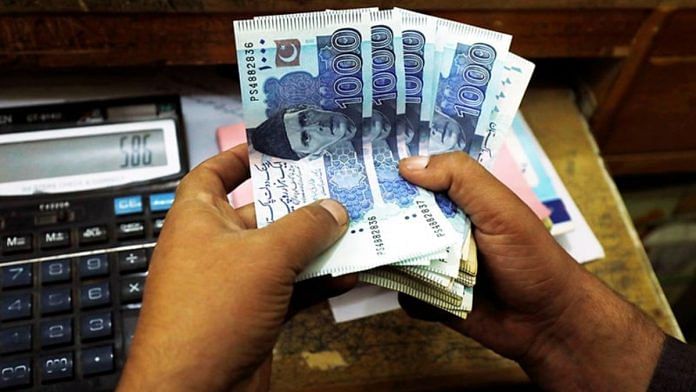New Delhi: China has emerged as Pakistan’s biggest creditor with its “iron brother” accounting for nearly 22 per cent of the country’s external debt, totalling approximately $28.8 billion. The next two biggest lenders are the World Bank with $23.55 billion credit and the Asian Development Bank at $19.63 billion. Critics argue that Pakistan could soon be merely the ‘supplicant in principal bilateral relations.’
Pakistan’s interest payments alone are equivalent to 43 per cent of its export revenues, one of the highest ratios in the world. The country is also among the top three loan recipients from the International Monetary Fund (IMF) this year.
Former finance minister Miftah Ismail told ThePrint that China is Pakistan’s largest creditor because many Chinese companies have built power plants and motorways in Pakistan on credit, which has been good for the Pakistani people and the economy.
“China is one of the few countries in the world on whom Pakistan has already relied and who have always helped Pakistan. That doesn’t mean we shouldn’t have friendly relations with other countries, including those in the region and in the West. However, as friendly as China is, dependency on any external power is never good. Pakistan can and must adopt policies that take it toward self-reliance,” he said.
In 2023, Pakistan’s total external debt, including loans from the IMF, reached $130.85 billion, or 352 per cent of its total exports. This heavy debt load, equivalent to 39 per cent of the country’s Gross National Income (GNI), underscores Pakistan’s precarious financial situation.
“The issue is less about Chinese debt and more about overall debt sustainability for Pakistan,” said Uzair Younus, Principal at The Asia Group, a strategic consulting firm based in Washington DC. “For external debt to be sustainable, Pakistan needs reforms that grow its exports, reform its energy markets, and ensure a more equitable tax burden across sectors.”
As Pakistan continues to struggle with high inflation, soaring debt, and a fiscal deficit, the government has turned to bilateral lenders like China, Saudi Arabia, and the UAE to ease the burden. In July, Pakistan finance minister Muhammad Aurangzeb acknowledged the country’s need for debt relief and reached out to these countries for help.
Pakistani economists, however, don’t see any silver linings in this situation. Analysts warn that Pakistan’s mounting debt to China could lead to greater political and economic vulnerabilities, potentially undermining the long-term stability of the relationship. Critics also argue that Pakistan’s reliance on external financing without comprehensive domestic reforms will only lead to deeper financial dependence and further crises in the future.
“With the country’s economic and foreign policy mainly focused on securing external financing and debt rollovers, Pakistan is at risk of being reduced to a supplicant in its principal bilateral relationships,” former Pakistan ambassador Maleeha Lodhi wrote in Dawn, in August.
“When other countries see Pakistan is doing what it can to help itself, they will be all the more willing to accede to its financing requests. Absent serious efforts at self-help bilateral lenders, however friendly, will think twice especially as the ‘beggar bowl’ approach will be perceived to have become an unshakeable habit,” she added.
Also read: Maryam Nawaz giving plots to Pakistani journalists. People say they’re ‘slave of the Sharifs’
China’s growing involvement in Pakistan
Pakistan is heavily reliant on Chinese loans, particularly in energy and infrastructure projects under the China-Pakistan Economic Corridor (CPEC). Despite these developments, Pakistan has been unable to meet its financial obligations to China, including a backlog of $1.9 billion in unpaid dues and an additional $16 billion in loans. This financial logjam has slowed the next phase of CPEC projects and raised tensions between the two nations, stated an October article in The Economist.
Pakistan is a key example of China’s strategy to strengthen ties with developing countries and challenge US influence. As part of China’s Belt and Road initiative, Pakistan signed $25 billion in agreements a decade ago, including power plants, roads, and a port. However, Pakistan guaranteed Chinese companies annual returns of up to 34 per cent for these power plants, requiring payments for installed generation capacity, regardless of usage. This has contributed to Pakistan’s growing debt burden, according to a Wall Street Journal report.
In September, Pakistan secured a new $7 billion loan from the IMF, with China assisting in rolling over $12 billion in credit. This deal, along with support from Saudi Arabia and the UAE, was critical in averting a default and ensuring continued financial assistance. Despite these efforts, Pakistan faces a mounting challenge to meet key targets set by the IMF, including privatising state-owned distribution companies (DISCOs) and imposing an agricultural income tax.
The crisis is a never-ending loop.
Pakistan is expected to miss five key targets the IMF set for receiving the second tranche of its loan, ARY News reported. The financial burden on Pakistan’s budget continues to grow, with the government spending over half of its budget on servicing debt.
(Edited by Prasanna Bachchhav)






